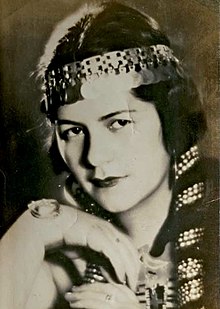music.wikisort.org - Singer
María Georgina Quitral Espinoza, commonly known as Rayén Quitral (7 November 1916 – 20 October 1979),[1] was a Chilean soprano of Mapuche-Picunche origin.[2] Known internationally for her interpretation of the Queen of the Night in the opera The Magic Flute, she was also made famous by her appearances dressed in Mapuche outfits, displaying her pride in her indigenous roots.[3]
Rayén Quitral | |
|---|---|
 Quitral in 1938 | |
| Born | María Georgina Quitral Espinoza 7 November 1916 |
| Died | 20 October 1979 (aged 62) Santiago, Chile |
| Occupation | Opera singer |
| Years active | 1937-1967 |
Biography
Rayén Quitral was born in Iloca, a coastal village in the commune of Licantén, in the Province of Curicó, Maule Region. She studied singing in her country and made her debut in the Central Theatre of Santiago in 1937.[4] In 1941, she debuted at the Colón Theatre of Buenos Aires, in the role of the Queen of the Night in the opera The Magic Flute. She made appearances in various countries in the Americas, later residing for a long period in Mexico.[5]
In Chile, she sang Lucia de Lammermoor in 1942 and performed as Gilda in Rigoletto in 1943. In 1950, she conducted a concert tour of Italy and France, as well as debuting in London with great success in 1951, once again with The Magic Flute,[5] which led her to make an appearance at Buckingham Palace.[4]
In 1967, she retired from the music business. She dedicated her final years to teaching lyrical singing to young people of limited means. On 19 September 1972, the government of Chile awarded her a gratuitous pension.[6] Rayén Quitral died in Santiago on 20 October 1979.
References
- "Rayén Quitral - Biografía". www.musicapopular.cl. 2012. Archived from the original (PHP) on 16 April 2014. Retrieved 15 April 2014.
- Lincolao Garcés, Guillermo; Ruíz Rodríguez, Carlos (2000). "Memoria de l@s mapuches urban@as: entre la integración con discriminación y la organización con identidad" [Memory of the urban Mapuche: between integration and discrimination, organization and identity]. In Olguín Tenorio, Myriam (ed.). Memoria para un nuevo siglo: Chile, miradas a la segunda mitad del siglo XX [Memory for a new century: Chile, views of the second half of the 20th century]. LOM Ediciones. p. 490. ISBN 978-956-282-222-0.
- González, Juan Pablo & Claudio Rolle (2005). Historia social de la música popular en Chile (1890-1950) [Social history of popular music in Chile (1890-1950)] (1st ed.). Ediciones UC.
- Peña Muñoz, Manuel (2001). Los Cafés Literarios en Chile [Literary Cafes in Chile]. Archivo del Escritor. p. 219. ISBN 978-956-284-206-8.
- La Prensa de Curicó (2009). "En Centro Cultural de Los Escalones fue lanzado libro sobre Rayén Quitral". www.diraiolaprensa.cl. Retrieved 11 March 2010.[permanent dead link]
- Library of the National Congree of Chile (1972). "Concede Pension, Por Gracia, A Doña Maria Georgina Quitral Espinoza" [Pension awarded to Maria Georgina Quitral Espinoza]. leychile.cl. Retrieved 19 August 2014.
На других языках
- [en] Rayén Quitral
[es] Rayén Quitral
María Georgina Quitral Espinoza,[2] más conocida por su nombre artístico Rayén Quitral[2] (Iloca, 7 de noviembre de 1916-Santiago, 20 de octubre de 1979),[3] fue una soprano chilena de origen mapuche-picunche.[4] Internacionalmente conocida por su interpretación de la Reina de la Noche en la ópera La flauta mágica, también se hizo conocida por sus presentaciones con atuendos mapuches, demostrando orgullo por sus raíces indígenas.[5]Другой контент может иметь иную лицензию. Перед использованием материалов сайта WikiSort.org внимательно изучите правила лицензирования конкретных элементов наполнения сайта.
WikiSort.org - проект по пересортировке и дополнению контента Википедии